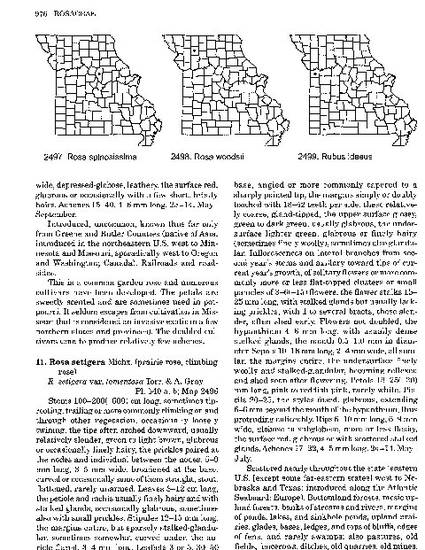
Plants shrubs (perennial herbs elsewhere), sometimes suckering or reproducing vegetatively from rooted stem tips. Stems (referred to as canes) biennial or (in sect. Rubus) occasionally persisting longer, prostrate, climbing, arched, or erect, all those found in Missouri armed with prickles, sometimes also with long, stiff bristles (except for horticultural selections); first year's stems generally vegetative (called primocanes), unbranched or few-branched (moderately branched in a few species); second year's stems fertile (called floricanes), usually dying back to the rootstock at the end of the second growing season. Leaves rarely evergreen. Stipules small to conspicuous, persistent, leaflike, fused to the petiole laterally or attached at the junction of the stem and petiole. Leaf blades palmately or pinnately compound, the margins toothed and sometimes lobed, the surfaces often hairy, sometimes with gland-tipped hairs or bristles, the main veins sometimes also with prickles. Inflorescences typically axillary on floricanes, of branched or simple clusters, racemes, panicles, or occasionally solitary flowers. Flowers perfect (imperfect elsewhere), with a noticeable hypanthium. Sepals 5, fused basally, persistent at fruiting, erect, horizontally spreading, or reflexed. Petals usually 5 (rarely more in horticultural selections), white or less commonly pale pink to rose pink, glabrous or hairy, the margins usually entire, rarely lobed (in R. laciniatus). Stamens numerous, the filaments attached at the mouth of the hypanthium. Pistils many, attached to an enlarged receptacle, this hemispheric, or becoming conic or cylindric as the fruits mature, each with 1 carpel and 2 ovules, 1 of these aborting as the fruit develops. Style 1, threadlike or occasionally narrowly club-shaped, glabrous or hairy. Fruits drupelets positioned on the enlarged receptacle to form an aggregate, which either separates freely from the receptacle when ripe (raspberries) or is shed with the receptacle attached (blackberries). About 800 species (although species concepts and the resulting estimates differ widely), worldwide, particularly abundant in temperate regions of the northern hemisphere.
Available at: http://works.bepress.com/mark_widrlechner/147/

This is a chapter from Widrlechner, Mark P. 2013. Rubus L. (raspberry, blackberry, bramble). Pages 976-977, 979-1004 In: Steyermark’s Flora of Missouri Vol. 3, by George Yatskievych. Missouri Botanical Garden Press and Missouri Department of Conservation, St. Louis and Jefferson City, MO.